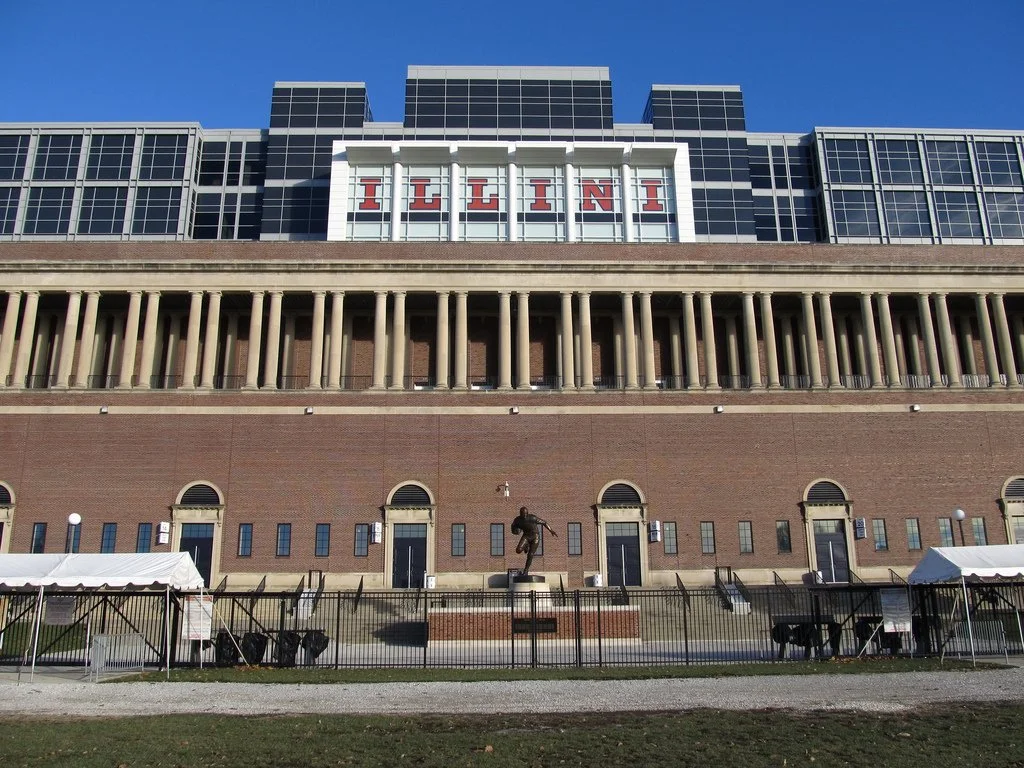$100 million gift to University of Illinois Athletics a great gift – and a travesty
A belated and sincere hats off to Larry Gies for his $100 million gift to help preserve Memorial Stadium and benefit UI athletics. It’s a great gift to help the preservation of a great stadium that was constructed more than a hundred years ago, in 1921, not long after World War I ended on Nov. 11, 1918.
Three years later, University of Illinois Athletic Director George Huff and football Coach Robert Zuppke decided to initiate a fundraising campaign to raise the money to erect a Memorial Stadium to honor the UI students and alumni who died in the war. And $700,000 in pledges were raised to begin work on the stadium and football playing field.
Memorial Stadium at the University of Illinois
The stadium was completed in 1923 by English Brothers Construction for $1.7 million and was dedicated on Oct. 18, 1924, in a game that saw Red Grange run wild against Michigan.
Memorial Stadium has been called “the house that Grange built.” But it wasn’t named Grange Memorial Stadium — even though there’s a statue of him on its west side.
Nor was the stadium where the Illinois football team has played ever since called George Huff and Robert Zuppke Memorial Stadium — the football field is named Zuppke Field after the coach — which would have taken away from the honor of those 189 students and alumni who sacrificed and gave their lives for our freedom. It was for their honor, pure and simple, that it was named Memorial Stadium. Nothing pretentious or self-serving about it.
The names of those 189 men and woman have since been listed on the limestone columns along the top of the stadium. That preservation of freedom and democracy was difficult to come by back then, and is increasingly more difficult to come by now in today’s divided country, where many people seek personal recognition, regardless of whether they deserve it.
But for Larry Gies, the University of Illinois Athletic Association and anyone else who was part of the decision to add “Gies” to Memorial Stadium for the generous and much-needed $100 million contribution, the name doesn’t bode well. It is still admirable that he made the gift in memory of his late father, Larry Gies Sr., a United States Army veteran who served, as many Illinois students and alumni have.
On Nov. 16, 2002, the University of Illinois extended the stadium’s original dedication to honor all members of the Illinois family who served in the United States military and gave their lives in our nation’s wars and conflicts.
That addition honors the 948 alumni, students, faculty and staff who were killed in our nation’s wars and conflicts since 1918.
The names of those who have given their lives since 2002 are engraved on one of four impressive limestone tablets at Memorial Stadium’s east and west colonnades alongside the names of their fallen World War I comrades. Only four UI students or alumni who were killed in Afghanistan remain to be added.
Just imagine what all those individuals who have been killed or died in our wars might have been like when they roamed the campus — the dreams they had about what a degree from the UI meant for their futures. Probably not a lot different than how students feel today. But those students and alumni back then went off to war for duty and country and didn’t get to come back and live their lives, nor have the chance to fully achieve their potential.
I’ve always appreciated the opportunity to share reflections and remember and honor the men and women who have served in the American military to protect us and preserve the freedom we enjoy. That’s what this Memorial Stadium has stood for all these years.
There isn’t a definitive count of all “Memorial Stadiums” in the U.S., as the term is used broadly for many different types of venues, including college and high school sports facilities, civic arenas and historical landmarks. But they’re there to honor those who sacrificed so we can still live in a free country.
There are at least dozens of venues with “Memorial Stadium” as their name in the efforts to honor fallen alumni, and some do include the name of the university, a donor, a coach or someone thought to be deserving. But many of them are simply “Memorial Stadium.”
Adding anyone’s name to the U of I’s Memorial Stadium for a significant monetary contribution is to disregard what Huff and Zuppke initiated more than 100 years ago to honor those Illini who died in World War I and have since continued to honor all whose lives that have been sacrificed in this country’s wars.
Some things should remain sacred, even in the face of a $100 million gift.

